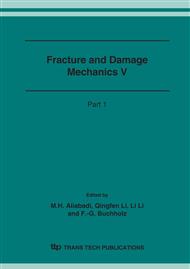p.73
p.77
p.81
p.85
p.89
p.93
p.97
p.101
p.105
Surface Stress Evaluation from Indentation Load-Depth Curves
Abstract:
In this work, we investigated the influences of residual stress on the load shifts, irreversible work from load vs. depth curves. It is found that there are linear relationships between the level of surface residual stress, the load shifts, and the variation of irreversible work for Ni, Ti, TiFe and A316L studied in this work. From these effects of residual stresses on load versus depth curves, depth-sensing indentation can be expected as a non-destructive method for measuring the residual stresses. Using the simulation results, the stresses estimated from the relationship of the level of surface residual stress and the load shifts, agree well with the applied stresses during simulations.
Info:
Periodical:
Pages:
89-92
Citation:
Online since:
November 2006
Authors:
Price:
Сopyright:
© 2006 Trans Tech Publications Ltd. All Rights Reserved
Share:
Citation:


